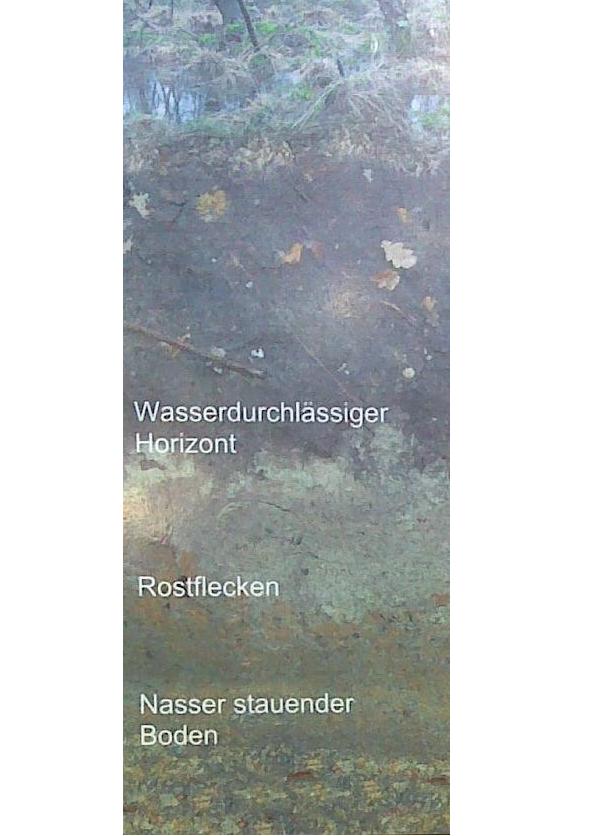|
 Unterbodenwelten: Der Waldboden
Unterbodenwelten: Der Waldboden
Noch vor 100 Jahren waren die Böden im Broich-Speldorfer Wald sehr viel feuchter als heute. Auf solchen naturbelassenen feuchten und nassen Böden wachsen Bruchwälder.
Viele Gräben durchziehen das Gelände heute und zeigen, wie unsere Vorfahren versucht haben den Boden "trocken" zu legen. Seitdem wird auch auf diesen ehemals sehr nassen Standorten Forstwirtschaft betrieben. In einigen Bereichen dieses Wald-
gebietes ist der Boden aber weiterhin so nass, dass dort weiter Bruchwälder wachsen können.
Wer einmal in einem Bruchwald war, der weiß woher der Name kommt. Im Gegensatz zu den Rotbuchenwäldern erscheint der Bruchwald durch die zahlreichen abgebrochenen Äste, die in den sumpfigen Gewässern liegen vielleicht etwas unordentlich.
Der Boden unter Bruchwäldern ist etwas ganz besonderes.
Hier befindet sich das Grundwasser nah unter der Oberfläche.
So wie das Wetter mal nass und mal trocken ist so schwankt auch der Wasserstand im Boden.
Unter der braunen Humusschicht, in der vor allem Pflanzenteile abgebaut werden, sehen wir zwei weitere sehr wichtige Boden-
schichten.
Die obere Schicht fällt zeitweise trocken und wird dann durch-
lüftet. Das im Boden enthaltene Eisen reagiert mit dem Sauer-
stoff, es oxidiert. Daher können wir gut sichtbare rostfarbene Flecken und Schlieren in dieser Bodenschicht sehen.
Die untere Schicht ist dauerhaft wassergetränkt. Wasser im Boden verdrängt Luft - es herrscht Sauerstoffmangel.
Das im Boden enthaltene Eisen liegt im Wasser gelöst und nicht mit Sauerstoff verbunden vor, das nennt man reduziert.
Wir erkennen diese Schicht an der blau-grauen Färbung und am Geruch. Denn durch den Sauerstoffmangel entstehen Fäulnisprozesse.
Die Fragen
Bitte begebt euch an die oben genannte Koordinate. Dort befindet sich eine Informations-
tafel. Lest euch die Tafel bitte sorgfältig durch und beantwortet folgende Fragen:
- Wie wird die oberste Bodenschicht auf der Infotafel beschrieben und welche Farbe hat sie neben der Grafik?
- Wie wird die unterste Bodenschicht auf der Infotafel beschrieben und welche Farbe hat sie neben der Grafik?
Achtung! Es werden genau die Angaben gesucht, die auf der Tafel gemacht werden! Internet Lösungen können leider nicht akzeptiert werden.
Die Log-Bedingungen
- Bitte schickt mir eine E-Mail mit den Antworten an folgende E-Mail Adresse:
Farbe aus Frage 2_Farbe aus Frage 1 [at] web.de
(Alles in Deutsch geschrieben. Umlaute [ä, ö, ü] bitte ausschreiben: ae, oe, ue)
- Macht optional ein Foto von euch vor der Tür zur Unterbodenwelt und fügt es eurem Log-Eintrag hinzu. Solltet ihr alleine unterwegs sein genügt ein Bild von eurem GPS mit sichtbaren Koordinaten.
Ich hoffe euch macht dieser EarthCache genau so viel Spaß wie mir! Ich danke euch für euren Besuch und freue mich auf eure E-Mails!
Liebe Grüße Ludon
 Unterbodenwelten: The forest floor
Unterbodenwelten: The forest floor
Just 100 years the soils in Broich-Speldorf forest were much wetter than today. On such natural moist and wet soils grow swamp forests.
Many ditches run through the site today and show what our ancestors have tried to lay the ground dry. Since then operated to this once very wet sites forestry. In some areas of this forest soil is so wet but still that there continue to grow swamp forests.
Anyone who was in a swamp forest, who knows where does the name. In contrast to the beech forests of the forest appears to break through the numerous broken-off branches, which lie in the marshy waters, perhaps a little messy.
The soil in swamp forests is something very special. Here is the groundwater close to the surface. Just as the weather is wet and dry times so the water level fluctuates in the soil.
Under the brown humus layer, are reduced in the particular parts of plants, we see two very important soil layers.
The top layer is at times dry and is then aerated. The iron contained in the soil reacts with the oxygen, it oxidizes therefore, we can see clearly visible rust-colored spots and streaks in this soil layer.
The lower layer is permanently waterlogged. Water displaces air in the soil - there exists a lack of oxygen. The iron contained in the soil is dissolved in the water and not associated with oxygen before this is called reduced. We recognize this shift in the blue-gray color and the smell. For lack of oxygen caused by the decay processes.

Questions
Please, head for coordinate mentioned above. There is an information board. Read the board carefully by and answers the following questions:
- How is the upper soil layers described on the notice board and what colors does it have next to the picture?
- How is the lowest soil layers described on the notice board and what colors does it have next to the picture?
Attention!The precise details are required, provided on the board! Unfortunately, solutions found in the internet cannot be accepted.
Log terms
- Please send me an e-mail with the answers to the following e-mail address:
Colour of Question 2_Colour of Question 1 [at] web.de
(All written in German. Umlauts [ä, ö, ü announce] please: ae, oe, ue)
- Take optional an picture of yourself in front of the door to the underbody world and add it to your log. If you’re alone on the move, a picture of your GPS with visible coordinates is enough.
I hope you will enjoy this EarthCache as much as I do. I thank you for your visit and looking forward to your e-mails!
Kind regards, Ludon!
|